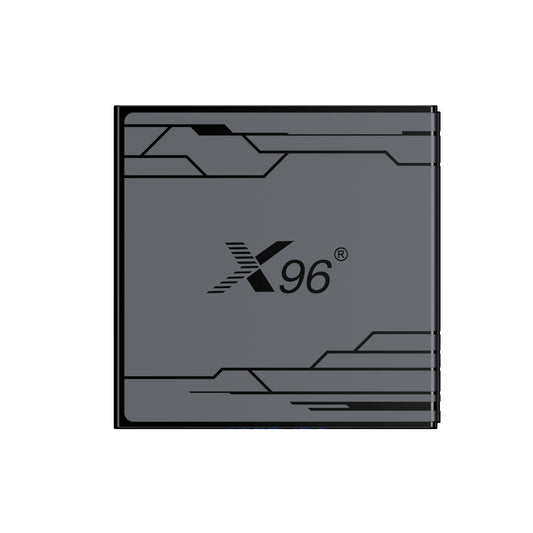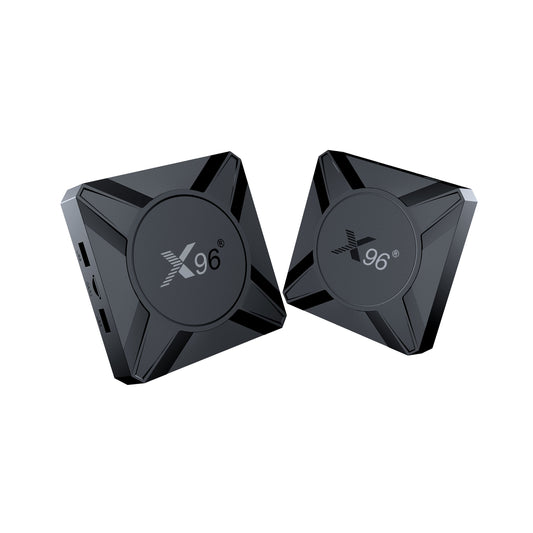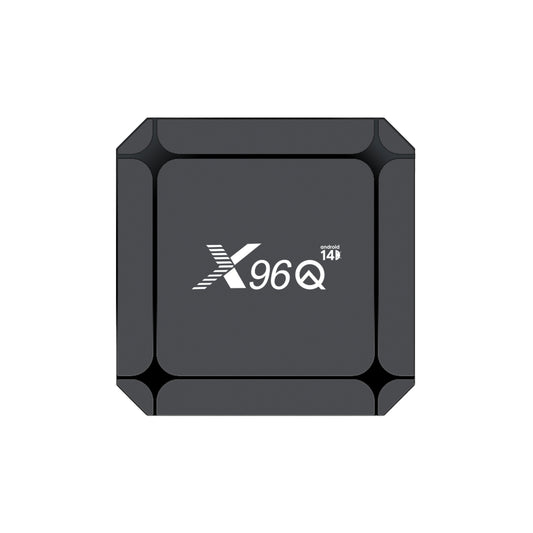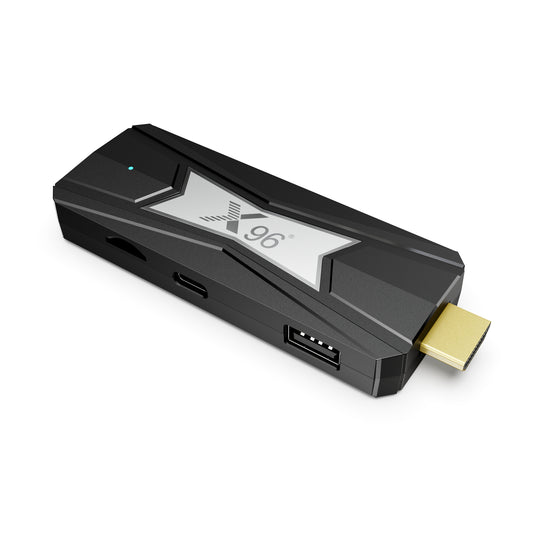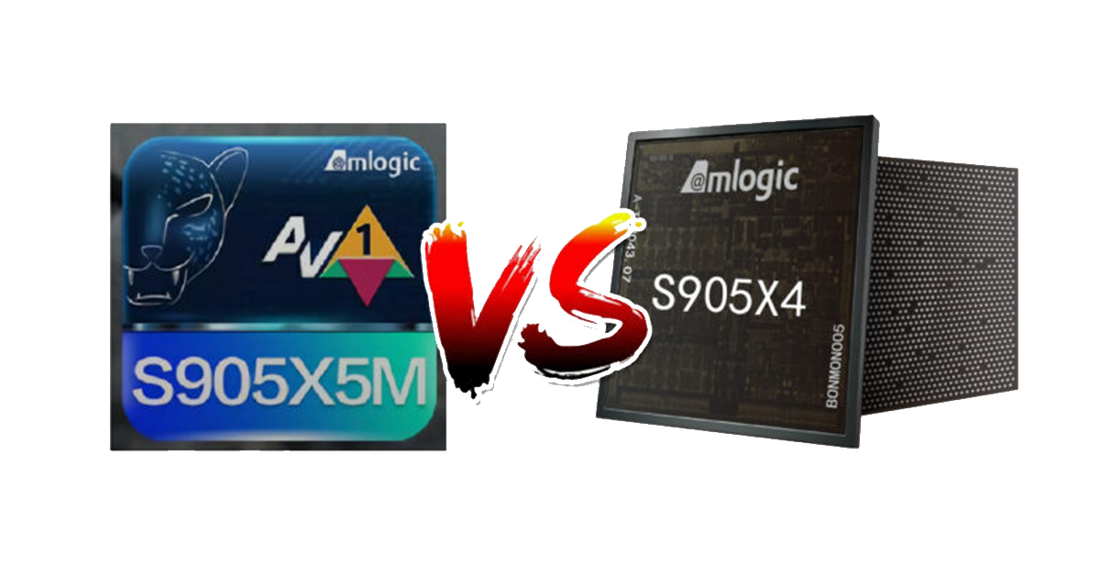
Amlogic S905X5M vs S905X4 – Updated Features and Benchmarks Comparison
Amlogic S905X5M is an update to the Amlogic S905X4 quad-core Cortex-A55 SoC with a higher 2.5 GHz CPU clock and a new generation Arm G310 CPU that delivers up to close to three times the performance of the Mali-G31 MP2 GPU for more advanced and smoother HDR user interfaces.
The S905X5M and S905X4 share the same video decoding capabilities, notably AV1 and H265 up to 4Kp75, but the new S905X5M drops support for H.265 1080p60 video encoding, only keeping H.264 1080p30. One of the new features is the inclusion of an NPU designed specifically for Super Resolution enabling video upscaling with better image quality. You’ll find the differences between the Amlogic S905X5M and S905X5 processors in the comparison table below.

|
|
S905M |
S905X4 |
|
CPU |
Quad-core Cortex-A55 up to 2.0 GHz |
Quad-core Cortex-A55 up to 2.5 GHz |
|
GPU |
Arm Mali-G31 MP2 |
Arm Mali-G310 V2 with HDR UI support |
|
Neural network accelerator |
N/A |
inline AI-SR (AISR2) |
|
Memory |
32-bit DDR3/3L/4, LPDDR3/4 |
16/32-bit DDR4/LPDDR4 up to 4GB, DDR3200 |
|
Storage I/F |
eMMC 5.0, NAND Flash, SD |
eMMC 5.2 with HW CQ & inline encrupt, SLC/QSPI NAND Flash, SD |
|
Video Output |
HDMI 2.1b 4Kp60 output with ALLM, eARC, CVBS |
HDMI 2.1b 4Kp60 output with ALLM, eARC, QMS, VRR, QFT, |
|
HDR |
HDR10/10+, HLG, |
HLG/HDR10/ 10+ Dolby vision |
|
Audio |
Stereo DACs, S/PDIF In and Out, 8-ch PDM, 12-ch I2S in, 12-ch I2S out |
Stereo DACs, S/PDIF In and Out, 4-ch PDM, 8-ch I2S in, 8-ch I2S out |
|
Video Decoding |
4Kp75 10-bit: AV1, H.265, VP9, AVS2; 4Kp30: H.264 |
|
|
Video Encoding |
1080p60 H.265/1080p30H.264 |
1080p30 H.264 |
|
Voice & Audio Processing |
VAD, ASRC/EQ/DRC, HiFi4 audio DSP |
VAD, ASRC/EQ/DRC |
|
DRM & CAS |
Widevine, PlayReady, VMX, TKL C2: Irdeto MSR4, Nagra NOCS3.2, NDS NSK2, VO |
Widevine, PlayReady, VMX, TKL |
|
Ethernet |
Gigabit Ethernet MAC, and 10/100M PHY |
|
|
USB and PCIe |
1x USB 2.0 OTG + 1x USB 3.0 or PCIe v2 + 2x USB 2.0 (OTG. Host) |
2x USB 2.0 (OTG, Host), USB-C CC |
|
Crypto Engine |
AES, TDES, SHA-1/SHA-2/HMAC, RSA |
AES, TDES, SHA-1/SHA-2/HMAC, RSA, ECC |
|
DVB |
4x Transport Stream (TS) inputs, ISO7816 smart card standard |
|
|
Package |
14x14mm BGA |
13.3x11mm BGA |
|
Manufacturing process |
12nm |
6nm |

### **1. Architecture and CPU**
- **Amlogic S905X5**
- **CPU**: Quad-core Cortex-A55 up to 2.5 GHz
- **Process**: "Second generation" 6nm
- **Performance**: 40K+ DMIPS
- **GPU**: ARM Mali-G310 V5, clocked at 1 GHz
- **AI Accelerator**: 4 TOPS NPU for AI-SR (Super-Resolution)
- **Amlogic S905X4**
- **CPU**: Quad-core Cortex-A55 up to 2.0 GHz
- **Process**: 12nm
- **Clock Speed**: Up to 2.0 GHz
- **GPU**: ARM Mali-G31 MP2
- **AI Accelerator**: Basic AI processing capabilities
### **2. Graphics and Video Decoding**
- **S905X5**
- **GPU**: Arm Mali-G310 V2 with HDR UI support
- **Video Decoding**: Supports up to 2x 4Kp60 10-bit H.266/VVC, AV1, VP9, AVS3, H.265/HEVC, H.264
- **HDR**: Supports 4K HDR interfaces
- **S905X4**
- **GPU**: Arm Mali-G31 MP2
- **Video Decoding**: Supports 4Kp60 10-bit H.265, AV1, VP9, H.264
- **HDR**: Supports HDR10, HLG, and other HDR formats
### **3. AI and Machine Learning**
- **S905X5**: Equipped with a 4 TOPS NPU, providing significant enhancements for AI tasks, such as AI-based Super-Resolution (AI-SR).
- **S905X4**: Includes Amlogic’s basic AI processing capabilities, suitable for standard tasks like voice recognition.
### **4. Connectivity and I/O**
- **S905X5**
- **HDMI**: HDMI 2.1 with eARC (enhanced audio return channel), VRR (Variable Refresh Rate), and QMS (Quick Media Switching)
- **USB**: 2x USB Type-A, 1x USB Type-C
- **Ethernet**: Gigabit Ethernet
- **Wi-Fi & Bluetooth**: Expected to support advanced standards, though details TBD
- **S905X4**
- **HDMI**: HDMI 2.1
- **USB**: USB 3.0 and USB 2.0
- **Ethernet**: Gigabit Ethernet
- **Wi-Fi**: Wi-Fi 5 (Wi-Fi 6 on some variants)
- **Bluetooth**: Bluetooth 5.0
### **5. Performance Benchmarks**
- **S905X5**: The advanced Armv9 cores, Mali-G310 GPU, and 4 TOPS NPU suggest a noticeable performance uplift, especially in multimedia and AI-enhanced tasks. The transition to a 6nm process also indicates better efficiency and thermals.
- **S905X4**: Known for solid performance in 4K media playback and general use, though it lacks the more advanced AI and video processing features of the S905X5.
### **6. Market Positioning**
- **S905X5**: Positioned as a higher-end SoC for next-gen TV boxes and smart devices, with advanced AI, video decoding, and connectivity features.
- **S905X4**: A widely used SoC for mainstream 4K TV boxes, offering reliable performance and broad support for current media standards.
The Amlogic S905X5M adds some HDMI 2.1 features that deserve an explanation:
- QMS (Quick Media Switching) – A source device can instantly switch its content’s resolution or frame rate without any display blackout, for example, when switching from 60 Hz to 24 Hz to watch a movie.
- VRR (Variable Refresh Rate) – Syncs up source and display with continually changing refresh rate, up to a frame-by-frame basis in order to reduce or eliminate interaction lag, stutter, and tearing.
- QFT (Quick Frame Transport) – Each video frame travels faster from the source even though the source does not increase its frame rate. This reduces lag for gaming and real-time interactive interfaces
- SBTM (Source-Based Tone Mapping)– Enables the source to send a video signal that takes full advantage of a specific display’s HDR capability by adjusting its output to take better advantage of each display’s features.
The Amlogic S905X5M also loses some features such as TCH PRIME DRM, the HiFi 4 audio DSP, and the USB 3.0/PCIe Gen2 interface. The latter is unlikely to be an issue for TV boxes and set-top boxes, but it’s disappointing for alternative use cases like single board computers. Note the Amlogic S905X5M is not to be confused with the more powerful Amlogic S905X5 SoC unveiled last year, and which is now scheduled to launch in about two months, according to SEI Robotics that provided the information above, along with the S905X4 vs S905X5M benchmarks comparison table below.

Android U refers to Android 14, and all benchmarks (Antutu 10.2.6, GFXBench 5.0.5, 3DMark 2.1) include 3D graphics tests showcasing the much higher performance of the Arm Mali-G310 V2 GPU that ranges from 132.45% to 180.08% increase in performance, or between 1.36 to 2.8 times faster. CPU performance has also increased by 16 to 36%, and memory bandwidth is much higher as well despite no big changes listed in the specifications provided by the company. The video below is supposed to show how the UI on the right (S905X5M) is rendering more smoothly than the UI on the left (S905X4), but I’m not 100% convinced that’s the best demo for the new GPU…
### **Conclusion**
The Amlogic S905X5 is a significant upgrade over the S905X4, bringing newer architecture, enhanced AI capabilities, and support for advanced video standards like H.266/VVC. It is more suitable for cutting-edge applications and devices requiring robust performance and future-proof features.
AMedia will not be one of the first companies to launch an Amlogic S905X5M powered TV box running Android 14 TV and implementing the new features listed above such as AI-SR, QMS, a faster user interface, Doby Audio, Dolby Vision, eARC, and so on.
Note the AMedia company is an ODM/OEM working with operators, specializing in designing, developing and manufacturing future-oriented high-end industrial electronic products for our dealer customers, including HD media players, video projectors and IoT devices, ARM hardware and software development, TV boxes and dongles, digital signage and advertising solutions.
🎉🌹Maximize your product offerings with X96’s highly customizable Android TV boxes, engineered for flawless compatibility and tailored to meet diverse market needs.
As the direct manufacturer, X96 delivers unbeatable wholesale prices and scalable solutions for volume orders. Inquire now for exclusive deals:
https://x96mini.com/

